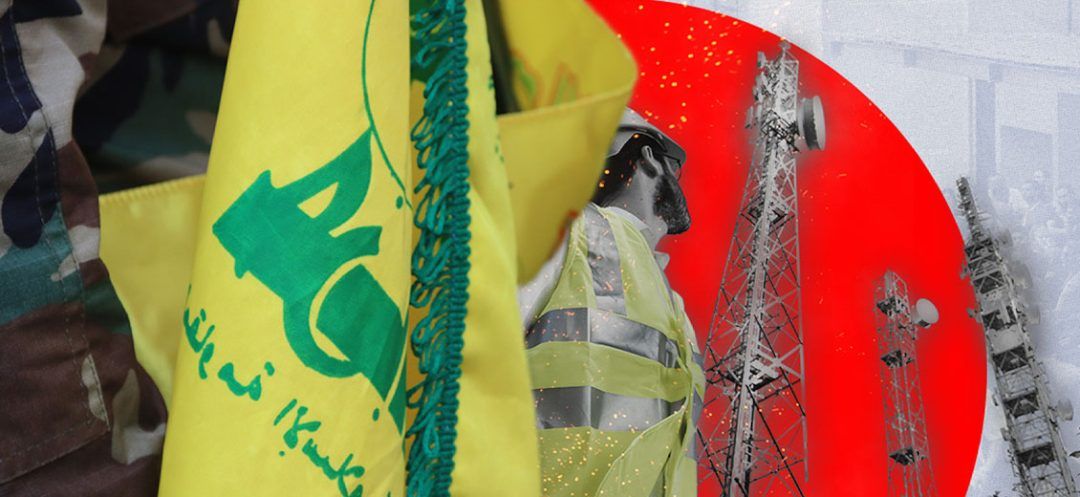
Hezbollah’s telecom network, which reportedly spans nearly the entire national territory, is believed to be used almost exclusively by its military wing and activated only in times of combat or large-scale conflict.
Israel's dramatic twin assault using booby-trapped transmission devices on Tuesday, September 17, and Wednesday, September 18, 2024, has reignited scrutiny of Hezbollah’s “private” communication network and raised doubts about its wartime reliability.
For years, Hezbollah had meticulously woven this network across nearly the entire country to ensure autonomy and safeguard its operations, but recent events have exposed its vulnerabilities.
The attacks highlighted that the communication system, once seen as a pillar of Hezbollah’s security, has now become its Achilles’ heel. Israeli forces had been tracking Hezbollah operatives for months, using their mobile phones to locate and eliminate commanders. In response, Hezbollah fighters switched to simpler, less traceable devices—devices that were, ironically, rigged with explosives.
In February 2024, Hezbollah's Secretary-General, Hassan Nasrallah, issued a warning during a speech broadcast by Al-Manar, the television channel of the group, widely followed by its supporters. Addressing his fighters after the elimination of several of Hezbollah’s leaders, he remarked, “Do you believe a spy is among us? Let me reveal who that spy is. It’s the smartphone you hold in your hands, the one your wives and children use. The smartphone is a lethal spying device that provides precise details to Israel.” He then announced “internal measures” to neutralize its effects and urged his fighters not to use smartphones, even framing the prohibition as a “duty dictated by Islamic law.”
Now that Israel has destroyed Hezbollah’s established communication network, the question arises: will the group be forced to revert to the very technology it had outlawed for critical wartime communications? The answer is unclear, as Hezbollah likely has other alternatives. Notably, despite the attacks, its “private” telecom network appears to have remained intact, a vital resource in the event of a larger conflict.
“Hezbollah will undoubtedly need to embark on a lengthy process that involves conducting internal investigations, purging its ranks of infiltrators collaborating with Israeli interests, and reassessing its entire logistics chain to ensure the security of future supplies, whether imminent or further down the line,” explains a European military official familiar with the situation, and who has served in Lebanon for several years.
Does this imply that Hezbollah will seek alternative communication methods? “What is certain is that it will change its operational procedures and enhance the security of its communication systems by procuring more advanced equipment with improved security features. Will it consider using jammers? Encryption devices? A new generation of pagers? Will it favor Chinese or Iranian products? These are questions only Hezbollah can answer,” he adds.
An Exclusive Network for Hezbollah's Armed Wing
What about Hezbollah's “physical” network? Was its establishment for nothing? “Having followed this dossier closely, I can tell you that the network is almost exclusively dedicated to Hezbollah's military wing and is only used in combat situations or large-scale wars,” notes the military official.
In his view, the procurement of pagers and walkie-talkies was intended to “carry out daily tasks,” supposedly providing Hezbollah with greater flexibility while avoiding exposure of its physical infrastructure.
“If the network is thus intended for tactical use, it must have remained intact, or nearly so,” he adds. However, he points out that Hezbollah finds itself in an embarrassing position: “If it uses its network too soon, it risks revealing it. Conversely, it must justify its utility without having utilized it.”
When asked if the network could have been hacked by Israel, he responds that this is very unlikely. “If such a situation were true, it would mean that the Hebrew State has deeply infiltrated Hezbollah, possesses a complete map of the network, and has access to several switching systems, which would raise many more questions.”
In this context, it is worth revisiting the “private” communication network that nearly triggered a civil war for Hezbollah.
This occurred in 2008 when the Lebanese government attempted to dismantle it. In May of that year, the director of security at Beirut airport, closely linked to the pro-Iranian formation, was dismissed under the impetus of Fouad Siniora's government, which simultaneously ordered the dismantling of the telecommunications network.
In response, Hezbollah effectively took control of Beirut, seizing the offices and positions of Siniora’s Future Movement, where limited armed clashes occurred before the group firmly established its dominance over the capital.
A Network Extending into Syria
This extensive effort is aimed at protecting a structure that has cost millions of dollars, stretching from Beirut to the Beqaa Valley, the Israeli-Lebanese border, and extending into Syria with connections reaching southern Damascus.
This network partially overlaps with Hezbollah's tunnel system, which spans a significant area of southern Lebanon, parts of the Beqaa, and reaches into southern Syria and the Israeli border.
While the tunnels serve as a defensive measure against a potential Israeli invasion, the telecommunications network serves two crucial purposes that Israel has sought to undermine: ensuring the security of the party's information exchanges and preventing Tel Aviv from intercepting internal communications. “From what I know, Hezbollah's telephone network covers at least all of southern Lebanon and certainly has extensions throughout Lebanon and into Syria,” emphasizes the military official interviewed by This is Beirut.
“Since the 2006 conflict, most—if not all—of this infrastructure has been buried wherever feasible. They are interconnected with fiber optics to reduce the risk of interception, whether through physical tapping or signal monitoring,” he explains.
He further notes, “The GSM component has likely evolved as well, but operations must be conducted through telecom companies to address legal considerations and ensure discretion.”
Iranian Support
Since the 1990s, Hezbollah has been diligently establishing its own communication network. Initially leveraging Lebanon's existing infrastructure for its strategic needs, the group has gradually achieved a degree of autonomy and built its own systems.
With assistance from Iran, particularly through Iran Telecom, as confirmed by multiple sources interviewed by This is Beirut, Hezbollah has integrated itself into the global communication landscape.
In 2007, Iran Telecom intervened through three entities: two Lebanese—Spectrum Investment, a telecommunications firm, and Jihad al-Bina, a construction company associated with Hezbollah—and one Iranian, MTN Irancell, which established private telephone networks in Lebanon equipped with high-frequency encrypted cells.
According to a European expert who has closely studied this issue, it is MTN Irancell's equipment, particularly the fiber optics, that is utilized in southern Lebanon.
Both Spectrum Investment and Jihad al-Bina are included on the US Office of Foreign Assets Control (OFAC) sanctions list. Spectrum Investment is accused of financing Hezbollah's telecommunications networks, thereby connecting the pro-Iranian group to the global telecom market and engaging in activities that support Hezbollah financially, operationally, and in intelligence.
As for Jihad al-Bina, it has reportedly facilitated the construction and funding of both the tunnel infrastructure and Hezbollah's communication network, according to information gathered by This is Beirut.
According to a US Treasury Department’s communiqué in 2007, this company had “used deceptive means to obtain funding from international development organizations for projects and construction services in Lebanon.”
Based in the Beqaa Valley, Jihad al-Bina is directly funded by Iran and operated by members of Hezbollah under the supervision of the Shura Council, chaired by the group's Secretary-General, Hassan Nasrallah.
Impact on the Official Network
Hezbollah's telecommunications network has undergone substantial development, incorporating the latest technologies. A complete shutdown of this network could severely disrupt Lebanon's State infrastructure, as the national systems serve as the “central node” connecting most branches of Hezbollah's operations, according to expert analysis.
Dismantling this network is complex for several reasons: its deep integration with national infrastructures, the difficulty of locating and neutralizing its diverse components, and the technological and operational challenges associated with dismantling both fixed and wireless networks. Furthermore, Hezbollah's capability to swiftly replace or restore affected components adds another layer of complexity.
What Elements Make Up the Network?
Hezbollah's telecommunications network is highly sophisticated, characterized by a distributed fiber optic architecture. It supports Voice over Internet Protocol (VoIP), enabling high-speed internet calls rather than relying on traditional lines. This network interfaces seamlessly with global technologies, facilitating anonymous cyber-attacks and funding through Virtual Private Networks (VPNs). Additionally, it comprises an Autonomous System (AS), Internet Protocol (IP), a range of IP addresses, a satellite, and other installations that will be elaborated upon shortly.
“We have the Autonomous Systems (AS) and their architectures, the IP addresses and ranges, and the name of the satellite in usage... Essentially, we possess the complete technical framework of Hezbollah’s telecommunications and all its communication protocols,” European military and security sources reported to This is Beirut. The network consists primarily of:
Landlines: In the event that terrestrial and mobile networks fail, Hezbollah relies on satellite phones, though these devices have limitations regarding coverage and cost.
Copper Cables: The “old fashioned” wired network is buried within Hezbollah's tunnels in southern Lebanon, extending into Syria and the Shebaa Farms. While vulnerable, these copper cables were used—until 2015—in conjunction with existing infrastructure to enhance Hezbollah's communication capabilities.
Fiber Optics: These cables transmit data using light pulses, offering increased security, although they are not entirely immune to interception attempts.
Mobile and Satellite Networks: Hezbollah uses these networks for a variety of operations, despite their susceptibility to jamming and interception, as highlighted by the party's Secretary-General, Hassan Nasrallah, in January 2024.
Internet: Although Internet connectivity is generally poor in Lebanon, it plays a crucial role in Hezbollah's communication strategy, enabling secure exchanges through email accounts and redirected servers. The group also utilizes encrypted instant messaging apps and VPNs with providers and operators known in Lebanon, the Near East, and even Africa.
Autonomous System (AS): An AS consists of a collection of IP networks managed under a single external routing policy, overseen by one or more organizations. Each AS is identified by a unique Autonomous System Number (ASN), and ASs communicate with each other using the Border Gateway Protocol (BGP) to exchange routing information.
Internet Protocol (IP): This protocol is essential for routing data packets from a source to a destination across interconnected networks. IP addresses serve as unique identifiers for each device connected to the network.
IP Ranges – An IP range refers to a continuous sequence of IP addresses that are allocated or reserved for specific purposes. These ranges can be assigned to businesses, Internet service providers, or set aside for specialized uses, such as private IP addresses.
Satellite – This pertains to the Khayyam satellite, launched by Iran on August 9, 2022, from the TTMTR (Tyuratam Missile and Space Complex). Its international designation is 2022-096A, and its NORAD identifier (a five-digit code assigned by US military authorities to any object in orbit) is 53370. This artificial satellite, currently in orbit around the Earth, facilitates various forms of communication, including data transmission for the Internet, television, radio, and other electronic communications. Satellites are crucial to Hezbollah's communication infrastructure, enabling long-distance connectivity and coverage in remote or hard-to-reach areas.
Read more



Comments